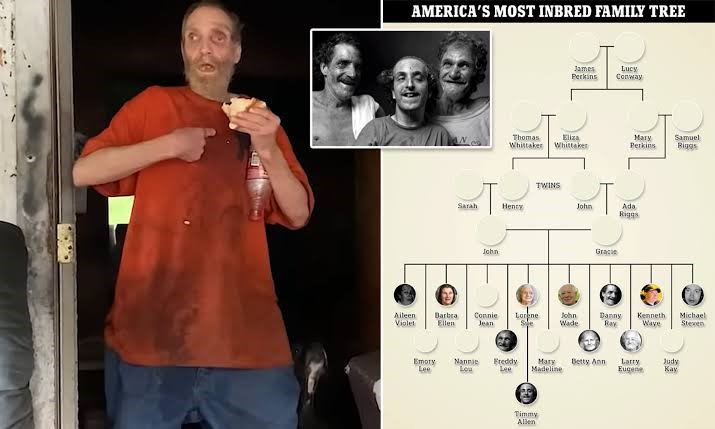The Whittakers are often considered one of the most inbred families in the United States. They gained public attention after American photographer Mark Laita featured them in his book “Created Equal” and in his YouTube documentaries.
This family, known for being highly inbred, has experienced numerous tragic genetic disorders originating from a pair of identical twin brothers. Residing in the small village of Odd in West Virginia, the Whittakers have a complicated background.
Some members of the family are only able to communicate through grunts and barks, and they frequently avoid interaction with outsiders. They have difficulty recalling their parents and other relatives, and it was only in recent years that they became aware that their problems stemmed from inbreeding.
The pattern of inbreeding originated with Henry and John Whittaker, who were identical twins. Their descendants married within the family, resulting in a family tree with over a dozen branches.

John Whittaker had nine children with his first cousin, Ada Riggs, including Gracie Irene Whittaker, born in 1920. Henry Whittaker had seven children with his wife Sally, and among them was John Emory Whittaker, born in 1913.
John Emory and Gracie married in 1935 and had 15 children. Being double cousins, they shared both sets of grandparents. Unfortunately, their offspring faced significant physical and mental challenges, likely due to their familial relationships.
Betty, born in 1952, now heads the family. She made a commitment to her mother to remain unmarried in order to care for all her siblings.
During Mark Laita’s flagship visit, the camera-wielding raconteur was approached by a shotgun-toting neighbor, who threatened to use it if the production team didn’t leave them alone.
“They don’t like people coming to ridicule these individuals,” noted Laita, who was eventually allowed to snap pictures despite the initial distrust.
Laita analogized the scene to something out of “Deliverance,” director John Boorman’s chilling, Oscar-nominated 1972 film about dueling-banjo mountain folk, based on the James Dickey novel of the same name.
“There’s these people walking around and their eyes are going in different directions and they are barking at us,” the astonished chronicler explained. “The one guy you’d look at him in the eye or say anything and he’d scream and go running away and his pants would fall around his ankles and he’d go running off and go kick the garbage can. This would happen over and over.”

The family from West Virginia had a complex history intertwined with generations of inbreeding. Initially, it was reported that the deceased parents of the three siblings were siblings themselves. However, the family later clarified that they were actually double first cousins, meaning they shared both sets of grandparents.
This practice of keeping relationships within the family resulted in various mental and physical abnormalities among the members. Some individuals can only communicate through grunts and noises, as observed in Laita’s videos shared on his podcast. Despite these challenges in communication, the Whittakers appeared to understand the photographer’s inquiries.
The Whittakers appeared unaware that their genetic challenges were a result of interbreeding within the family. When the photographer asked Kenneth why their eyes were not facing forward, he attributed it to possible effects from coal mining.
Naturally, Laita’s series might raise concerns of exploitation, reminiscent of a carnival sideshow. Melody West and Shane Simmons from the Real Appalachia YouTube channel recently criticized the documentary for perpetuating the long-standing stereotype of Appalachian inbreeding.
However, Laita, who has also worked on commercials for major brands like Nike and Apple, stated on Konkrete that his intention was to shed light on the level of poverty experienced by the Whittaker family.
Sources
- https://www.legit.ng/ask-legit/biographies/1517214-meet-whittakers-inbred-family-united-states/
- https://www.news.com.au/lifestyle/real-life/true-stories/meet-the-whittakers-inside-americas-most-inbred-family-that-speaks-in-grunts/news-story/d21ec992408301a6b5f23de5c299d572?amp
- https://www.reddit.com/r/UsefulCharts/comments/15e14l6/the_whittakers_the_most_inbred_nonroyalty_family/
- https://www.news.com.au/lifestyle/real-life/true-stories/meet-the-whittakers-inside-americas-most-inbred-family-that-speaks-in-grunts/news-story/d21ec992408301a6b5f23de5c299d572?amp
- . https://www.legit.ng/ask-legit/biographies/1517214-meet-whittakers-inbred-family-united-states/




